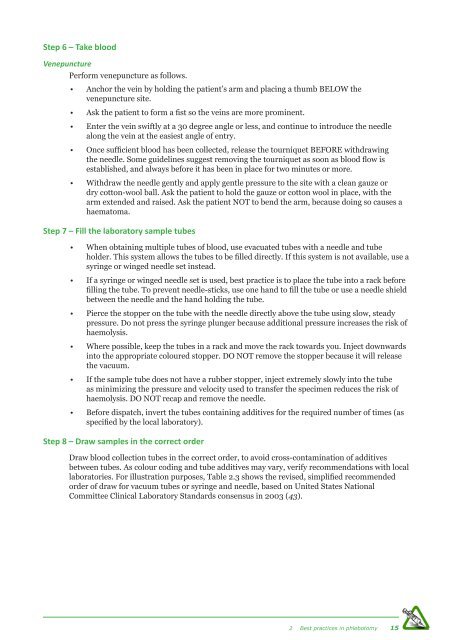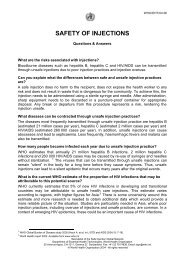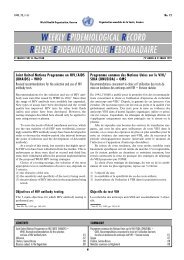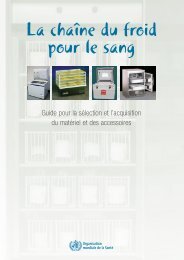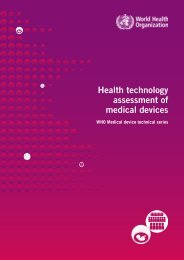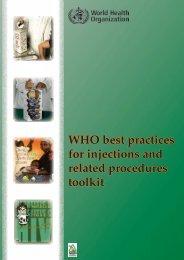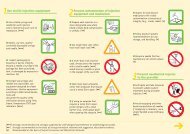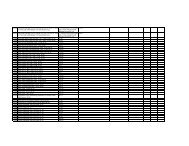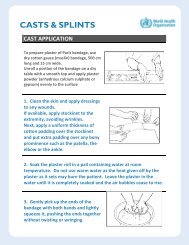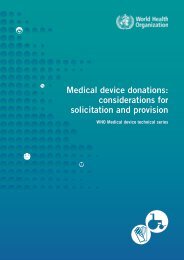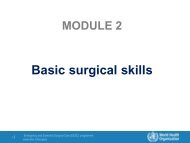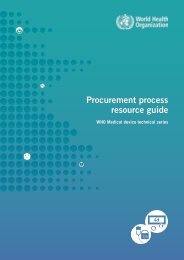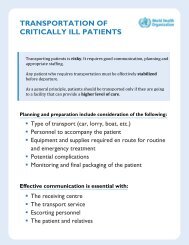WHO Guidelines on Drawing Blood: Best Practices in Phlebotomy
WHO Guidelines on Drawing Blood: Best Practices in Phlebotomy
WHO Guidelines on Drawing Blood: Best Practices in Phlebotomy
- No tags were found...
You also want an ePaper? Increase the reach of your titles
YUMPU automatically turns print PDFs into web optimized ePapers that Google loves.
Step 6 – Take blood<br />
Venepuncture<br />
Perform venepuncture as follows.<br />
• Anchor the ve<strong>in</strong> by hold<strong>in</strong>g the patient’s arm and plac<strong>in</strong>g a thumb BELOW the<br />
venepuncture site.<br />
• Ask the patient to form a fist so the ve<strong>in</strong>s are more prom<strong>in</strong>ent.<br />
• Enter the ve<strong>in</strong> swiftly at a 30 degree angle or less, and c<strong>on</strong>t<strong>in</strong>ue to <strong>in</strong>troduce the needle<br />
al<strong>on</strong>g the ve<strong>in</strong> at the easiest angle of entry.<br />
• Once sufficient blood has been collected, release the tourniquet BEFORE withdraw<strong>in</strong>g<br />
the needle. Some guidel<strong>in</strong>es suggest remov<strong>in</strong>g the tourniquet as so<strong>on</strong> as blood flow is<br />
established, and always before it has been <strong>in</strong> place for two m<strong>in</strong>utes or more.<br />
• Withdraw the needle gently and apply gentle pressure to the site with a clean gauze or<br />
dry cott<strong>on</strong>-wool ball. Ask the patient to hold the gauze or cott<strong>on</strong> wool <strong>in</strong> place, with the<br />
arm extended and raised. Ask the patient NOT to bend the arm, because do<strong>in</strong>g so causes a<br />
haematoma.<br />
Step 7 – Fill the laboratory sample tubes<br />
• When obta<strong>in</strong><strong>in</strong>g multiple tubes of blood, use evacuated tubes with a needle and tube<br />
holder. This system allows the tubes to be filled directly. If this system is not available, use a<br />
syr<strong>in</strong>ge or w<strong>in</strong>ged needle set <strong>in</strong>stead.<br />
• If a syr<strong>in</strong>ge or w<strong>in</strong>ged needle set is used, best practice is to place the tube <strong>in</strong>to a rack before<br />
fill<strong>in</strong>g the tube. To prevent needle-sticks, use <strong>on</strong>e hand to fill the tube or use a needle shield<br />
between the needle and the hand hold<strong>in</strong>g the tube.<br />
• Pierce the stopper <strong>on</strong> the tube with the needle directly above the tube us<strong>in</strong>g slow, steady<br />
pressure. Do not press the syr<strong>in</strong>ge plunger because additi<strong>on</strong>al pressure <strong>in</strong>creases the risk of<br />
haemolysis.<br />
• Where possible, keep the tubes <strong>in</strong> a rack and move the rack towards you. Inject downwards<br />
<strong>in</strong>to the appropriate coloured stopper. DO NOT remove the stopper because it will release<br />
the vacuum.<br />
• If the sample tube does not have a rubber stopper, <strong>in</strong>ject extremely slowly <strong>in</strong>to the tube<br />
as m<strong>in</strong>imiz<strong>in</strong>g the pressure and velocity used to transfer the specimen reduces the risk of<br />
haemolysis. DO NOT recap and remove the needle.<br />
• Before dispatch, <strong>in</strong>vert the tubes c<strong>on</strong>ta<strong>in</strong><strong>in</strong>g additives for the required number of times (as<br />
specified by the local laboratory).<br />
Step 8 – Draw samples <strong>in</strong> the correct order<br />
Draw blood collecti<strong>on</strong> tubes <strong>in</strong> the correct order, to avoid cross-c<strong>on</strong>tam<strong>in</strong>ati<strong>on</strong> of additives<br />
between tubes. As colour cod<strong>in</strong>g and tube additives may vary, verify recommendati<strong>on</strong>s with local<br />
laboratories. For illustrati<strong>on</strong> purposes, Table 2.3 shows the revised, simplified recommended<br />
order of draw for vacuum tubes or syr<strong>in</strong>ge and needle, based <strong>on</strong> United States Nati<strong>on</strong>al<br />
Committee Cl<strong>in</strong>ical Laboratory Standards c<strong>on</strong>sensus <strong>in</strong> 2003 (43).<br />
2 <strong>Best</strong> practices <strong>in</strong> phlebotomy 15


